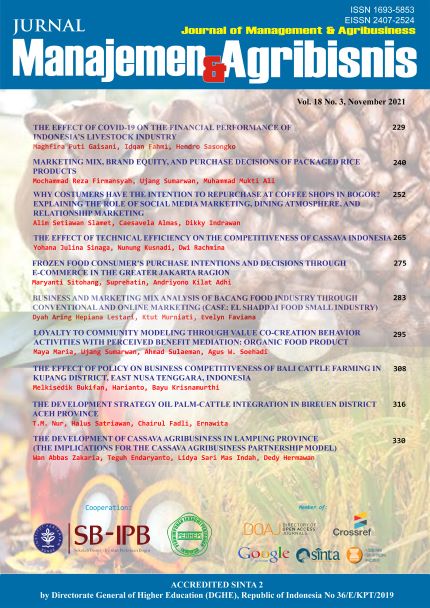The Growth Performance and Costs of Rearing Friesian Crossbreed Dairy Young Stock in Malaysian Commercial Farm
Abstract
The important elements in rearing dairy young stock are good farm management, proper growth and optimal costs of rearing. A survey on these important elements was conducted at two commercial farms in Johor and Sabah in 2019. The farm herd size is 214 heads and 2,221 heads with 163,682 litres and 4.2 mil. litres of milk production, in Johor and Sabah respectively. In addition, the body weight data of 188 dairy young stock was collected and analysed to determine the growth performance using polynomial growth function. The results showed the two farms have youngstock with different Friesian blood levels (60% and 70% in Johor, and 87.5% in Sabah) with different growth performance. The average weight of dairy young stock with 60%, 70% and 87.5% Friesian blood levels at birth were 21.31±3.70kg, 22.33±2.23kg and 26.55±2.68kg, respectively, while average weight at 3 months of age were 45.00±7.07kg, 55.57±8.36kg and 75.84±12.54kg, respectively. Heifers with 87.5% Friesian blood levels was bred at 15 months of age (444kg) while heifers with lower Friesian blood levels was bred 6 months later (250kg). The average rearing (feed) cost was RM4,932 (USD1,194)/heifer. The findings of this study can give awareness and insights in the performance and costs of rearing crossbreed dairy young stock in tropics.
Keywords: tropical, dairy, young stock, management, rearing cost
Authors
Authors who publish with this journal agree to the following terms:
- Authors retain copyright and grant the journal right of first publication with the work simultaneously licensed under a Creative Commons Attribution License that allows others to share the work with an acknowledgement of the work's authorship and initial publication in this journal.
- Authors are able to enter into separate, additional contractual arrangements for the non-exclusive distribution of the journal's published version of the work (e.g., post it to an institutional repository or publish it in a book), with an acknowledgement of its initial publication in this journal.
- Authors are permitted and encouraged to post their work online (e.g., in institutional repositories or on their website) prior to and during the submission process, as it can lead to productive exchanges, as well as earlier and greater citation of published work (See The Effect of Open Access).

